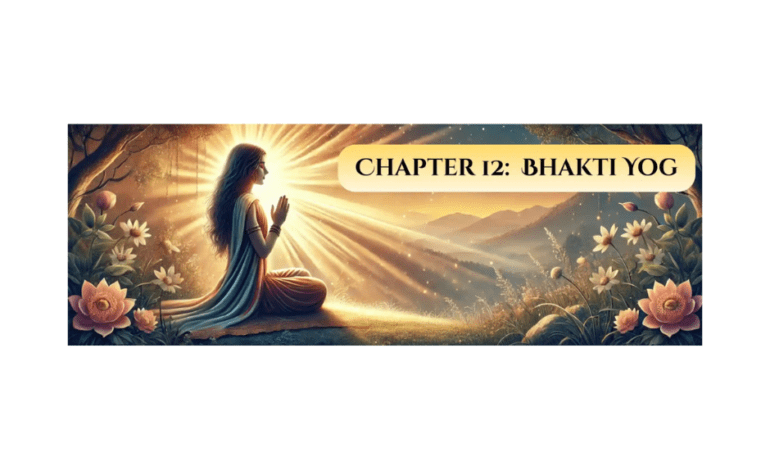
Gita Study – In My Understanding: Chapter 12 – The Yoga of Devotion (Bhakti Yoga)
By: Rajender Kapil
The twelfth chapter of the Bhagavad Gita is known as Bhakti Yoga, the Yoga of Devotion. In this chapter, Lord Krishna explains two primary paths to attain Him:
- The Path of Knowledge (Jnana Yoga) – the way of the wise who seek to realize the Supreme through study, reflection, and meditation.
- The Path of Devotion (Bhakti Yoga) – the way of pure faith and love, where the devotee surrenders completely to God through heartfelt remembrance and worship.
The path of knowledge demands deep intellectual discipline, scriptural study, and austerity—it is a difficult road. The path of devotion, however, is simpler and more accessible. It requires only shraddha (faith) and prem (love). There are countless ways to remember and adore God, all natural and easy. Perhaps for this reason, about five centuries ago, Bhakti Yoga became the most popular path in India. Saints and poets like Tulsidas spread its message far and wide through their divine poetry.
Tulsidas beautifully expressed the essence of devotion through his couplets:
“Nij anubhav ab kahun khagesa, binu Hari bhajan na jahi kalesa.”
“Ram kripa binu sunu khagarai, jani na jai Ram prabhutai.”
“Binu biswas bhagati nahi, tehi binu dravahi na Ram.”
“Ram kripa binu sapnehun, jeev na lah vishram.”
Tulsidas declares that without faith, there can be no devotion; without devotion, one cannot receive the grace of Lord Ram; and without that grace, the soul can never find peace—even in dreams.
A true devotee loses himself in divine love, dancing and singing in ecstasy:
“Payo ji maine Ram ratan dhan payo,”
or
“Mere to Giridhar Gopal, doosro na koi.”
The Question of Arjuna
This chapter begins with Arjuna’s question:
“O Madhava, who is superior—the devotee who worships You with form, or the one who contemplates You as the formless Absolute?”
Lord Krishna answers:
“Mayyaveshya mano ye maam nityayuktaa upasate,
Shraddhaya parayopetaaaste me yuktatamaa mataah.” (12.2)
Meaning:
O Arjuna, those who fix their minds on Me, ever steadfast in worship with supreme faith, are considered by Me to be the most perfect in Yoga.
The path of knowledge, Krishna says, is indeed difficult:
“Klesho’dhikataras tesham avyaktasakta chetasam,
Avyakta hi gatir duhkham dehavadbhir avapyate.” (12.5)
Meaning:
For those whose minds are attached to the formless, realization is very difficult; as long as one identifies with the body, the formless is hard to grasp.
But those who dedicate all their actions to Me, meditate upon Me with single-minded devotion, and surrender completely—
“Tesham aham samuddharta mrityu samsara sagarat,
Bhavaami nachiraat Partha, mayyaaveshita chetasam.” (12.7)
Meaning:
I swiftly rescue such devotees from the ocean of birth and death, for their minds are steadfastly fixed on Me.
The path of knowledge may lead to ego—attachment to one’s spiritual success. The devotee, however, loses all sense of self in loving surrender. His remembrance of God becomes constant and effortless. Guru Nanak described it perfectly:
“Naam khumaari Nanaka, chhadi rahe din raat.”
(The intoxication of God’s Name remains day and night.)
Therefore, Krishna advises Arjuna:
“If you cannot fix your mind on Me, then at least surrender the fruits of all your actions to Me.”
“Shreyo hi jnaanam abhyaasaat, jnaanaad dhyaanam vishishyate,
Dhyaanaat karma phala tyagas, tyaagaat shantir anantaram.” (12.12)
Meaning:
Better than mechanical practice is knowledge; better than knowledge is meditation; better than meditation is renunciation of the fruits of action—for peace immediately follows such renunciation.
The Character of a True Devotee
The devotee who truly surrenders to God becomes peaceful and pure in heart. He bears no hatred, harbors no ego, and loves all beings equally. Even if wronged, he forgives.
A poet once wrote:
“Rahe sada tusht santusht khud, kare na kuch parvaah,
Jisse bhagti dridh gyaan ki, rahti har kshan chaah.”
Such a devotee is ever content, detached from material desires, and free from pride or attachment.
Krishna describes the qualities of such a devotee:
“Yo na hrishyati na dweshti na shochati na kaankshati,
Shubhaashubha parityaagi bhaktimaan yah sa me priyah.” (12.17)
“Samah shatrau cha mitre cha tathaa maanaapamaanayoh,
Sheetoshna-sukh-dukheshu samah sang vivarjitah.” (12.18)
“Tulya nindaa stutir maunee santushto yena kenachit,
Aniketah sthiramatir bhaktimaan me priyo narah.” (12.19)
Meaning:
He who neither rejoices nor hates, neither grieves nor desires, who renounces good and evil results alike—such a devotee is dear to Me.
He who is the same to friend and foe, in honor and dishonor, in heat and cold, in joy and sorrow—free from attachment and self-centeredness—is dear to Me.
He who accepts praise and blame equally, is silent and content with whatever comes his way, has no fixed home, and is steady in devotion—such a man is dear to Me.
Thus, in this chapter, Lord Krishna lovingly simplifies the path of Bhakti Yoga for Arjuna—and for all seekers. He assures that those who worship Him with faith and surrender, seeing Him as their ultimate refuge, will surely attain His divine abode.
For such pure-hearted devotees, God Himself takes care—just as a parent protects a beloved child.
With folded hands and deep reverence, we bow to Lord Krishna—
“Jai Shri Krishna.”
Disclaimer:
This article represents a reflective and devotional interpretation of Bhagavad Gita – Chapter 12 (Bhakti Yoga) as understood by the writer. It is not a literal translation or commentary by any particular sect or scholar but an independent expression meant for readers of the Dharam Karam section of IndoUS Tribune.